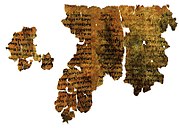| Jewish mysticism | ||||||||||||||||||||||||||||
|---|---|---|---|---|---|---|---|---|---|---|---|---|---|---|---|---|---|---|---|---|---|---|---|---|---|---|---|---|
 | ||||||||||||||||||||||||||||
| History of Jewish mysticism | ||||||||||||||||||||||||||||
Forms
|
||||||||||||||||||||||||||||
The Hekhalot literature (sometimes transliterated Heichalot) from the Hebrew word for "Palaces", relating to visions of ascents into heavenly palaces. The genre overlaps with Merkabah or "Chariot" literature, concerning Ezekiel's chariot, so the two are sometimes referred to together as "Books of the Palaces and the Chariot" (ספרות ההיכלות והמרכבה). The Hekhalot literature is a genre of Jewish esoteric and revelatory texts produced some time between late antiquity – some believe from Talmudic times or earlier – to the Early Middle Ages.
Many motifs of later Kabbalah are based on the Hekhalot texts, and the Hekhalot literature itself is based upon earlier sources, including traditions about heavenly ascents of Enoch found among the Dead Sea scrolls and the Hebrew Bible pseudepigrapha. Hekhalot itself has many pseudepigraphic texts.
Texts

Some of the Hekhalot texts are:
- Hekhalot Zutartey "Lesser Palaces" or "Palaces Minor", which details an ascent of Rabbi Akiva through the seven heavens, seeking revelations regarding the holy name of God
- Hekhalot Rabbati "Greater Palaces" or "Palaces Major", which details the ascent of Rabbi Ishmael when he sought to examine the validity of the decree regarding the execution of the Ten Martyrs
- Maaseh Merkabah "Account of the Chariot", a collection of hymns recited by the "descenders" into the holy chariot, and heard during their ascent;
- Merkavah Rabba "Greater Chariot"
- 3 Enoch or "Book of Palaces"
Other similar texts are:
- Re'uyyot Yehezqel "The Visions of Ezekiel"
- Massekhet Hekhalot "The Tractate of the Palaces"
- Shi'ur Qomah "Divine Dimensions"
- Sefer HaRazim "Book of the Mysteries"
- The Sword of Moses
- Alphabet of Rabbi Akiva
Dating and genre
The Hekhalot literature is post-rabbinical, and not a literature of the rabbis, but since it seeks to stand in continuity with the Rabbinic literature, it is often pseudepigraphical.
Hekhalot has examples of early alternate history texts.
See also
- Merkabah mysticism
- Primary texts of Kabbalah
- Seven Heavens
- Smaller midrashim
- Mystical ascent in Midrash Eleh Ezkerah
- Ten Martyrs
References
- Scholem, Gershom, Jewish Gnosticism, Merkabah Mysticism, and the Talmudic Tradition, 1965.
- ^ Elior, Rachel (1993). "Mysticism, Magic, and Angelology: The Perception of Angels in Hekhalot Literature". Jewish Studies Quarterly. 1 (1): 5. ISSN 0944-5706. JSTOR 40753108.
- Schäfer, Peter (1992). The hidden and manifest God: some major themes in early Jewish mysticism. State University of New York Press. p. 7. ISBN 9780791410448.
- Don Karr. "Notes on the Study of Merkabah Mysticism and Hekhalot Literature in English" (PDF). Retrieved 21 December 2010.
- Judaism in late antiquity: Volume 1 - Page 36 Jacob Neusner, Alan Jeffery Avery-Peck, Bruce Chilton - 2001 "The Hekhalot literature is "not a literature of the rabbis, yet it seeks to stand in continuity with the Rabbinic literature" (p. 293); this literature is deeply pseudepigraphical and as such post-rabbinical."
External links
- The Zoharic Seven Heavens
- The Heichalot & the Merkavah, (The Palaces & The Chariot)
- Notes on the Study of Merkabah Mysticism and Hekhalot Literature in English
- English translation of the Hekhalot Rabbati
This Kabbalah-related article is a stub. You can help Misplaced Pages by expanding it. |